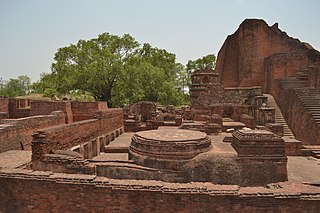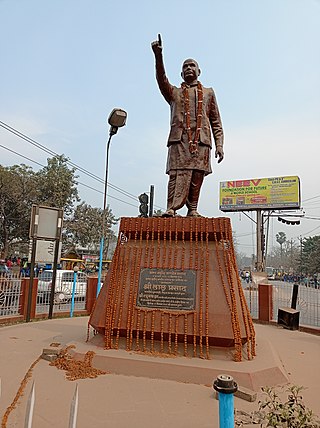
Lalu Prasad Yadav is an Indian politician and president of the Rashtriya Janata Dal (RJD). He is a former Chief Minister of Bihar (1990-1997), a former Railway Minister of India (2004-2009), and a former Member of Parliament (MP) of the Lok Sabha.
The Other Backward Class (O.B.C.) is a collective term used by the Government of India to classify castes which are educationally or socially backward. It is one of several official classifications of the population of India, along with General castes, Scheduled Castes and Scheduled Tribes. The OBCs were found to comprise 52% of the country's population by the Mandal Commission report of 1980, and were determined to be 41% in 2006 when the National Sample Survey Organisation took place. There is substantial debate over the exact number of OBCs in India; it is generally estimated to be sizable, but many believe that it is higher than the figures quoted by either the Mandal Commission or the National Sample Survey.

Raja Bindheshwari Prasad Mandal was a scion of the erstwhile Murho Estate and an Indian politician who chaired the Mandal Commission. Mandal came from a rich Yadav Royal family from Madhepura in Northern Bihar. He served as the seventh Chief Minister of Bihar in 1968, but he resigned after 30 days. As a parliamentarian, he served as the chairman of the Second Backward Classes Commission, popularly known as the Mandal Commission. The commission's report mobilized a segment of the Indian population known as "Other Backward Classes" (OBCs) and initiated a fierce debate on policies related to underrepresented and underprivileged groups in Indian politics.

Nalanda district is one of the thirty-eight districts of the state of Bihar in India. Bihar Sharif is the administrative headquarters of this district. The districts is home to the ancient Nalanda Mahavihara a UNESCO World Heritage Site. Nalanda is located in the Magadh region of southern Bihar.

Nitish Kumar is an Indian politician, who is serving as 22nd Chief Minister of Bihar since 22 February 2015, having previous held the office from 2005 to 2014 and for a short period in 2000. He is the leader of the Janata Dal (United). Previously, Kumar also served as a Union Minister as the Samata Party member.He was member of the Samata Party until 2005 and Janata Dal from 1989 to 1994. Kumar first entered politics as a member of the Janata Dal, becoming an MLA in 1985. A socialist, Kumar founded the Samata Party in 1994 along with George Fernandes. In 1996 he was elected to the Lok Sabha, and served as a Union Minister in the government of Atal Bihari Vajpayee, with his party joining the National Democratic Alliance. In 2003 his party merged into the Janata Dal (United), and Kumar became its leader. In 2005, the NDA won a majority in the Bihar Legislative Assembly, and Kumar became chief minister heading a coalition with the Bharatiya Janata Party.
Kushwaha is a community of the Indo-Gangetic Plain that has traditionally been involved in agriculture, including beekeeping. The term has been used to represent different sub-castes of the Kachhis, Koeris and Muraos. Under the Indian governments system of positive discrimination, the Kushwahas are classified as a "Backward" or Other backward class. The Kushwaha had worshipped Shiva and Shakta, but beginning in the 20th century, they claim descent from the Suryavansh (Solar) dynasty via Kusha, one of the twin sons of Rama and Sita. In Bihar, many Koeris, who possess land, education and government jobs have become upwardly mobile and demonstrate upper-caste characteristics.
At the 2011 Census, Bihar was the third most populous state of India with total population of 104,099,452, nearly 89% of it rural. It was also India's most densely populated state, with 1,106 persons per square kilometre. The sex ratio was 918 females per 1000 males. Almost 58% of Bihar's population was below 25 years age, which is the highest in India. At 11.3%, Bihar has the second-lowest urbanisation rate in India after Himachal Pradesh.
The politics of Bihar, an eastern state of India, is dominated by regional political parties. As of 2021, the main political parties are Rashtriya Janata Dal (RJD), Bharatiya Janata Party (BJP), Janata Dal (United) (JDU). There are also some smaller regional parties, including Samata Party, Hindustani Awam Morcha, Rashtriya Lok Janata Dal, Jan Adhikar Party and Vikassheel Insaan Party, Lok Janshakti Party and Rashtriya Lok Janshakti Party, which play a vital role in politics of state. As of 2022, Bihar is currently ruled by Mahagatbandhan (Grandalliance) coalition.
The Lonia or Nonia are Hindu other backward caste, found in Uttar Pradesh and Bihar adjoining areas, who were traditionally involved in salt-making activities. The Lonia or Nonia are listed as extremely backward caste along with Mallah, Bind and Beldar communities, by state governments. The community leaders have been seeking Scheduled Tribe status for the socially deprived community.Traditionally, Upparas, Lonari of South India share same occupation.

The voter turnout in 2000 assembly polls was 62.6%.
The Koeri, also referred to as Kushwaha and more recently self-described as Maurya in several parts of northern India are an Indian non-elite caste, found largely in Bihar and Uttar Pradesh, whose traditional occupation was agriculture. According to Arvind Narayan Das they were horticulturist rather than agriculturists. They are also recorded as performing the work of Mahajan in credit market of rural parts of Bihar and Bengal in 1880s. Koeris have attempted Sanskritisation— as part of social resurgence. During the British rule in India, Koeris were described as "agriculturalists" along with Kurmis and other cultivating castes. They are described as a dominant caste in various opinions.

Upendra Kumar Singh commonly Known as Upendra Kushwaha is an Indian politician and a former Member of Bihar Legislative Council and Bihar Legislative Assembly. He has also served as the Minister of State for Human Resources and Development in the Government of India. Kushwaha is a former Member of parliament from the Karakat constituency in Rohtas district, Bihar and a former member of the Rajya Sabha as well. He was the leader of his own party named Rashtriya Samata Party (RSP) which merged into Janata Dal (United) (JDU) in 2009. Later, he formed Rashtriya Lok Samata Party (RLSP), which also merged with JD(U) in 2021. On 20 February 2023, he resigned from all positions of Janata Dal (United) and formed his own party called Rashtriya Lok Janata Dal due to his political problems with JD(U) & Nitish Kumar.

The Legislative Assembly election was held over five-phases in Bihar through October–November 2015 before the end of the tenure of the prior Legislative Assembly of Bihar on 29 November 2015.

Babu Jagdeo Prasad, alternatively spelled as Jagdev Prasad and popularly known as Jagdev Babu, was an Indian politician and a member of the Bihar Legislative Assembly who served as Bihar's deputy chief minister in 1968 for four days in the Satish Prasad Singh cabinet. A socialist and a proponent of Arjak culture, he was the founder of Shoshit Dal and was a staunch antagonist and critic of India's caste system. He was nicknamed as the "Lenin of Bihar".
The Socio Economic and Caste Census 2011 (SECC) was conducted for the 2011 Census of India. The Manmohan Singh government approved the Socio Economic and Caste Census 2011 to be carried out after discussion in both houses of Parliament in 2010. SECC-2011 was not done under the 1948 Census of India Act and the Registrar General and Census Commissioner of India was not entrusted to do the same. The SECC 2011 was conducted in all states and union territories of India and the first findings were revealed on 3 July 2015 by Union Finance Minister Arun Jaitley. SECC 2011 is also the first paperless census in India conducted on hand-held electronic devices by the government in 640 districts. The rural development ministry has taken a decision to use the SECC data in all its programmes such as MGNREGA, National Food Security Act, and the Deen Dayal Upadhyaya Grameen Kaushalya Yojana. SECC 2011 was the first caste-based census since 1931 Census of India, and it was launched on 29 June 2011 from the Sankhola village of Hazemara block in West Tripura district.

Mahagathbandhan (MGB), also known as Grand Alliance, is a coalition of political parties in the Eastern state of Bihar in India, formed ahead of the 2015 Vidhan Sabha elections in Bihar. The alliance consists of Rashtriya Janata Dal (RJD), Janata Dal (United), Indian National Congress (INC) and Left parties including Communist Party of India (CPI), Communist Party of India (Marxist–Leninist) Liberation-CPIML (Liberation) and Communist Party of India (Marxist) (CPIM), with Nitish Kumar as the leader and Tejashwi Yadav as the chairperson. It is the ruling coalition government in Bihar.
Youth For Equality is an Indian organisation against caste-based policies and reservations, i.e. affirmative action. It was founded by students in a number of Indian universities in 2006. It organises demonstrations and legal challenges against caste-based policies.

The 2021 Census of India, or the 16th Indian Census, is to be conducted in two phases, a house listing phase and a population enumeration phase. Although initially the house listing was to begin in April 2020 along with the updating of the National Population Register, and the population enumeration on 9th February 2021, they have been effectively postponed to after the 2024 general elections. Initially the house listing was to be conducted between April and September 2020, with population enumeration in February 2021 and a revision round in March 2021. The reference date was to be 1 March 2021 in most of the states and 1 October 2020 for Jammu and Kashmir and some areas of Himachal Pradesh and Uttarakhand. On 2 January 2023, Additional Registrar General of India communicated to all the states that the date of freezing of administrative boundaries had been extended till 30 June 2023. The 16th Census can only begin three months after the administrative boundaries have been frozen. The completion of the census in its two phases takes at least 11 months, so the possibility of the completion of this decennial census exercise in 2023 or early 2024 is ruled out, as general elections are due in April 2024.
The Upper Backward Caste is a term used to describe the middle castes in Bihar, whose social and ritual status was not very low and which has traditionally been involved in the agricultural and animal husbandry related activities in the past. They have also been involved in low scale trade to some extent. The Koeri, Kurmi, Yadav and Bania are categorised as the upper-backwards amongst the Other Backward Class group; while the various other caste groups which constitutes the OBC, a group comprising 51% of the population of state of Bihar, has been classified as lower backwards. The upper-backwards also called upper OBC represents approximately 20.3% of the population of Bihar. These agricultural caste were the biggest beneficiaries of the land reform drive which was undertaken in the 1950s in the state and they strengthened their economic position by gaining a significant portion of excess land under the ceiling laws, which prohibited the ownership of land above a certain ceiling.

The Luv-Kush equation is a political term used in the context of the politics of Bihar, to denote the alliance of the agricultural Kurmi and the Koeri caste, which together constitutes approximately 15% of the state's population. The alliance of these two caste groups has remained the support base of Nitish Kumar, as against the MY equation of Lalu Prasad Yadav, which constitutes Muslims and the Yadavs. Caste consciousness and the quest for political representation largely drive the politics of Bihar. The political alliance of the Koeri and the Kurmi castes, termed the "Luv-Kush equation" was formed when a massive Kurmi Chetna Rally was organised by members of the Kurmi community in 1994 against the alleged casteist politics of Lalu Yadav, who was blamed by contemporary community leaders for promoting Yadavs in politics and administration.











